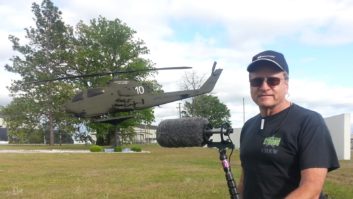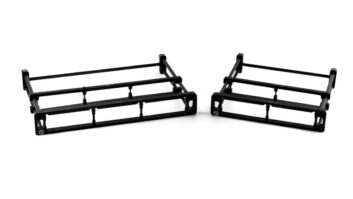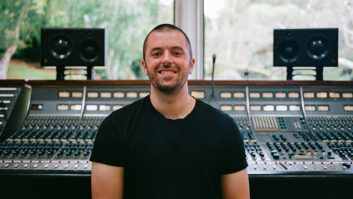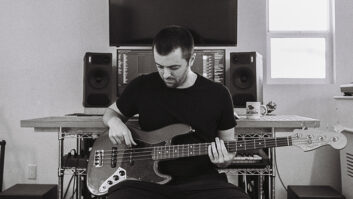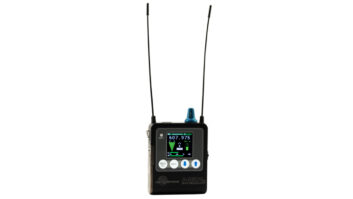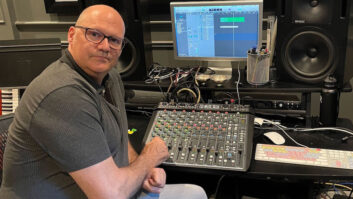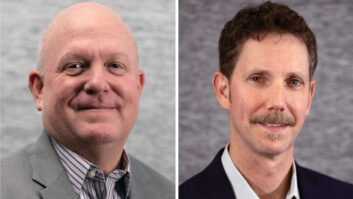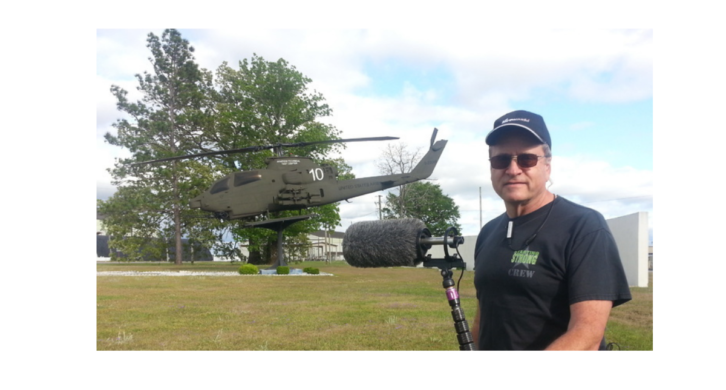
Fort Rucker, AL (January 26, 2022) — Any production sound professional is familiar with the range and reception challenges of car-to-car recording. Rob Smith, however, may be the only mixer to take on helicopter-to-helicopter audio and achieve high-flying results. Smith, whose credits include Preacher, Queen of the South, and Duck Dynasty, faced this task while filming Starting Strong. Produced by Ricky Schroeder’s Old Post Films beginning in 2014, the series looks behind the scenes at careers in the U.S. Army. To make his mission possible, he relied on Lectrosonics Digital Hybrid Wireless — specifically UCR411a receivers paired with SMV and SMQV transmitters and HMa plug-ons for booms, plus R1A receivers for producers’ and directors’ IFB monitoring.
“Cairns Army Airfield at Fort Rucker is where aspiring young pilots train to fly helicopters,” begins Smith. “They’ve earned a lot of credentials to get to this point, where they’re training in Bell Jet Rangers and Eurocopters. The job of me and my colleague Bob Tiwana — who originally supplied all the Lectrosonics gear — was to capture both all the radio communications between the helicopter crew and the tower, as well as chatter inside the copters between students and instructors. For one series of shots, we strapped into the back seat with our camera operator, with a minimum of 12 of the 411s between our two kits. These fed Sound Devices 788T recorders. Some SMV and SMQV transmitters were wired into the radio comms while others picked up Sanken COS-11 mics on the students’ persons. Obviously, we got everything with no problems.”
That was the easy part. “Here’s where it got interesting,” Smith foreshadows. “The aircraft the students are in, we call it the show copter. We still had a camera in its back seat, but we had to fly in formation with it in a separate copter as these pilots practiced touch-and-go landings and takeoffs where they learn to avoid power lines and things of that nature. Because of course, we needed exterior footage of the maneuvers, we needed to fly above it to get a shot looking down at the rotors, and so forth. On several occasions, we got well over 1,000 feet away from the show copter and still got all the dialogue with no issues. The producers were on the ground listening to their R1a beltpacks, and they came up to me afterwards and said, ‘Wow, how were you doing that?’ They could hear everything like it was happening right next to them.”
Smith emphasizes that this impressive reception was not due to powered antennas, a luxury he did not have. “Space was very tight inside our Blackhawk follow copter,” he explains. “There was absolutely no room to set up shark fins or anything like that. So, what makes it more unbelievable is that we were getting all this crystal-clear audio using just the whips on the 411s. With many different people talking all at once, we were easily able to isolate everyone for post-production.”
Yet another scene, this time with the sound department on the ground, presented even greater range demands. Smith reports his UCR411a receivers did not flinch. “After that, we still had the transmitters on the students and they had to fly a pattern around an airspace known as the practice box,” he says. “At times, I’ll bet they were two miles away from us. We had their audio. That was amazing.”
Smith also notes that anytime the human voice needs to convey emotion, it’s not just the fact the audio is being received clearly, but also the sonic character of that signal, that matters. “Things have to sound analog,” he specifies. “I don’t care what’s going on in the digital part of the equation, which I know is important. The sound needs to be organic and pleasing to the human ear. That’s where my Lectrosonics gear does an incredible job. Not to mention, it’s super quiet. The bottom line is, if I can hear it, somebody else can hear it. It could be the director. It could be one of the script people.”
For those above-the-line personnel, Smith heaps particular praise on Lectrosonics IFB systems. “Some of my colleagues say I’m spoiling people because they don’t deserve a receiver that nice,” he laughs. “I have 14 of them because, one, they’re robust. Two, they can get wet and still work. Three, the battery gives you six hours if you use lithium rechargables. Lastly, they have that organic sound and great range. If someone walks away to the craft table to get coffee, they still hear everything. Those little things come back to you in terms of future work.”
No less important to Smith is durability and reliability of operation, even when he’s not flying around in Army helicopters. “I’ve gone entirely Lectrosonics in my production kit because the stuff leaves me alone,” he explains. “It frees me up to focus on other crucial parts of my job, such as mic placement. To me it’s the Caterpillar bulldozer of wireless, practically military-spec. And on the rare occasion something doesn’t work right, they make it work right. Anytime I’ve ever talked to their factory, it’s always someone who knows what’s going on. They get it. That’s money well spent.”
About Lectrosonics
Well respected within the film, broadcast, and theatre technical communities since 1971, Lectrosonics wireless microphone systems and audio processing products are used daily in mission-critical applications by audio engineers familiar with the company’s dedication to quality, customer service, and innovation. Lectrosonics received an Academy Scientific and Technical Award for its Digital Hybrid Wireless® technology and is a US manufacturer based in Rio Rancho, New Mexico. Visit the company online at www.lectrosonics.com.
